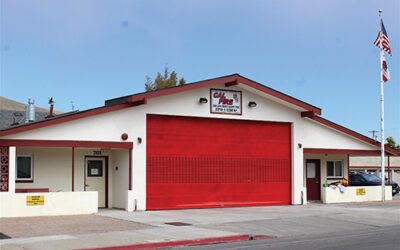This drone photo shows the Limekiln Creek Bridge on Hwy 1, located just north of Lucia, which is being replaced due to ‘chloride intrusion’ rusting out the rebar inside the bridge’s concrete pillars. Caltrans plans to have a replacement bridge in place by November 2030. Photo courtesy Caltrans
Caltrans is starting work on a major bridge replacement for Hwy 1 near Lucia, holding an online, virtual information meeting yesterday to introduce the public to what promises to be a long and very expensive fix to the State’s most scenic stretch of coastal highway.
Called the “Limekiln Creek Bridge Replacement Project,” Caltrans proposes to replace the 580-foot long concrete bridge that stands high above the beach at Limekiln State Park. It is one of several historic bridges on the stretch of Hwy 1 through Monterey County and Big Sur.
“Caltrans proposes to replace the existing concrete Limekiln Creek Bridge in Monterey County on Highway 1 near Lucia,” reads the project description on Caltrans’ website. “Within the limits of the proposed project, Highway 1 is a 2-lane undivided highway with two, 10- to 12-foot lanes and 0- to 4-foot non-standard shoulders. The proposed project lies exclusively within the Limekiln State Park property.”
Access to the State Park and Beach is via an off ramp at one end of the bridge and people access the white sand beach by walking underneath the bridge. Built in 1957, the existing bridge has eight tall piers and abutments at either end of the bridge.
The eventual construction zone will span from Post Marker 20.9 to 21.3, according to Caltrans’ online map.

A map shows the scope of the Limekiln Creek Bridge.
Photo courtesy of Caltrans
As with other stretches of the Big Sur Highway, the area has problems. “The purpose of the project,” Caltrans reports, “is to ensure the reliability of Highway 1 for the traveling public, support the movement of essential goods and services, and maintain coastal access along this section of the Big Sur Coast by addressing chloride intrusion in Limekiln Creek Bridge and slope stability problems.”
A Caltrans team investigated the condition of the bridge’s concrete in 2012 and discovered the chlorine intrusion within.
According to the website concrete.org.uk: “Chloride ingress is a common cause of deterioration of reinforced concrete structures. Concrete may be exposed to chloride by seawater or deicing salts; chloride initiates corrosion of the reinforcement, which through expansion disrupts the concrete.”
So while chloride (basically salt) doesn’t harm the actual concrete, it can corrode the steel reinforcing bar with, which in turn makes a structure unstable and subject to potential collapse.
If its caught early, there are simpler ways to combat chloride intrusion, including using “Electrochemical Chloride Extraction” (ECE), passing an electrical current through the pillars to withdraw the chloride from the concrete, which is then sealed to keep from corroding again.
That’s what was done with the Big Creek Bridge on Hwy 1, just a few miles north of Limekiln, according to a Caltrans spokesman. But Limekiln was apparently too far gone for that fix.
“There has been irreversible damage to the superstructure and substructure elements,” Caltrans reports, “caused by chloride intrusion from pervasive salt-laden fog. This has resulted in frequent concrete cracking and reinforced steel and cable corrosion.”
Also, “There have also been recurring slope stability problems at the north abutment caused by powerful waves. There have been attempts to stabilize this slope; however, it is not possible to permanently stabilize it.” Ironically, the south side of the creek mouth is solid granite.
Another State agency’s actions have led to the bridge’s complete replacement. “There is a permit requirement [Coastal Development Permit 3-09-020] from the California Coastal Commission to remove the existing slope armoring,” Caltrans said, referring to piles of boulders placed at the foot of a seawall. “As a result of these issues, the need for replacing the existing bridge was identified by the Structure Maintenance and Investigations peer review committee in its October 2012 meeting.”
But with the decision to remove the armoring and replace Limekiln Creek Bridge comes the question of funding. Caltrans has over $100 million in hand. The website lists the State funding sources at $11.74 million; Federal monies at $90.62M; and total construction costs at a whopping $102.36M. Such State and Federal highway maintenance monies are generated through taxes on fuel.
According to the work schedule posted by Caltrans they plan to be done with environmental review in March 2024 and finish the design and be ready for bids in June 2026. The plan is to start construction in July 2027 and finish the new bridge in November 2030.
The project EIR analyzed different options for doing the job and Caltrans Dist. 5 spokesman, Kevin Drabinski, said the intention is to keep traffic flowing on Hwy 1 during the lengthy construction.
That’s potentially good news for the tourist towns on Hwy 1 that can see business negatively affected by road closures. Major landslides and in some cases multiple landslides each of the past several winters has meant road closures, long delays and even complete detours inland to Hwy 101 for the estimated 5 million vehicles a year that traverse that magic coastal highway to visit the Central Coast.



